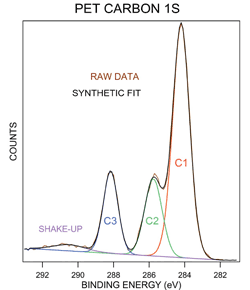X-Ray and UV Photoelectron Spectroscopy
NLR uses X-ray and UV photoelectron spectroscopy to analyze chemical states, elements, depth profiling, polymers, and variable temperatures.
How It Works
In photoemission techniques, we use either X-rays or UV photons to bombard the surface of a sample. The incident photons cause the emission of electrons (photoelectrons) from atoms in the near-surface region (about the top 4 nm) of the sample.

High-resolution XPS spectra of carbon 1s from polyethylene terephthalate backsheet material, showing excellent quantitative agreement between measured and predicted peak area ratios. Subtle differences in polymer functionality are assessed by deviations from stoichiometry.
In X-ray photoelectron spectroscopy (XPS), the photoelectrons have energies characteristic of the atom they came from, allowing us to make elemental and chemical determinations. Ultraviolet photons used for UV photoelectron spectroscopy (UPS) have lower energies and probe the electrons in the outermost valence levels of the surface atoms, yielding surface electronic structure information such as work function and valence band-edge.
Applications
Chemical state
Evaluates bonding environments of surface layers via XPS, and valence states via UPS. Ultrahigh vacuum facilitates sample cleanliness. Aluminum, magnesium, and monochromated Al Kα radiation allow a variety of analytical conditions. A high-resolution electron energy analyzer minimizes the spread of photoelectrons, allowing accurate determination of energies and enhanced peak separation for accurate chemical identifications.

High-resolution XPS spectra of carbon 1s from polyethylene terephthalate backsheet material, showing excellent quantitative agreement between measured and predicted peak area ratios. Subtle differences in polymer functionality are assessed by deviations from stoichiometry.
Elemental Analysis
Uses quantitative identification of elements from lithium to uranium by XPS, with detection levels down to 0.5 at.%.
Depth Profiling
Uses argon ion gun equipped for sputter cleaning of the surface and for limited compositional depth profiles of layers <1 µm thick.
Polymers
Used to analyze functional groups in polymers and other organic materials. Particularly useful in this regard when used as a complementary tool with static SIMS analysis.
Versatile Sample Capabilities
Accommodates standard semiconductor materials, insulators, powders, irregular geometries, polymers, catalyst particles, and biological and cell materials.
Nondestructive Depth Profiling
Using angle-resolved photoelectron spectroscopy, photoelectron spectroscopy is performed over a range of angles — from normal to the surface to nearly parallel to it—changing the sampling depth for photoelectrons. This yields a nondestructive method for producing depth profiles of near-surface regions.
Variable-Temperature Manipulator
Allows the acquisition of XPS and UPS data at variable temperatures (-50° to +800°C). Useful for in-situ cleaning of sample surfaces and temperature-programmed XPS/UPS studies.
Contact
Share
Last Updated Dec. 6, 2025
